2023 TOYOTA PRIUS PLUG-IN HYBRID weight
[x] Cancel search: weightPage 57 of 818
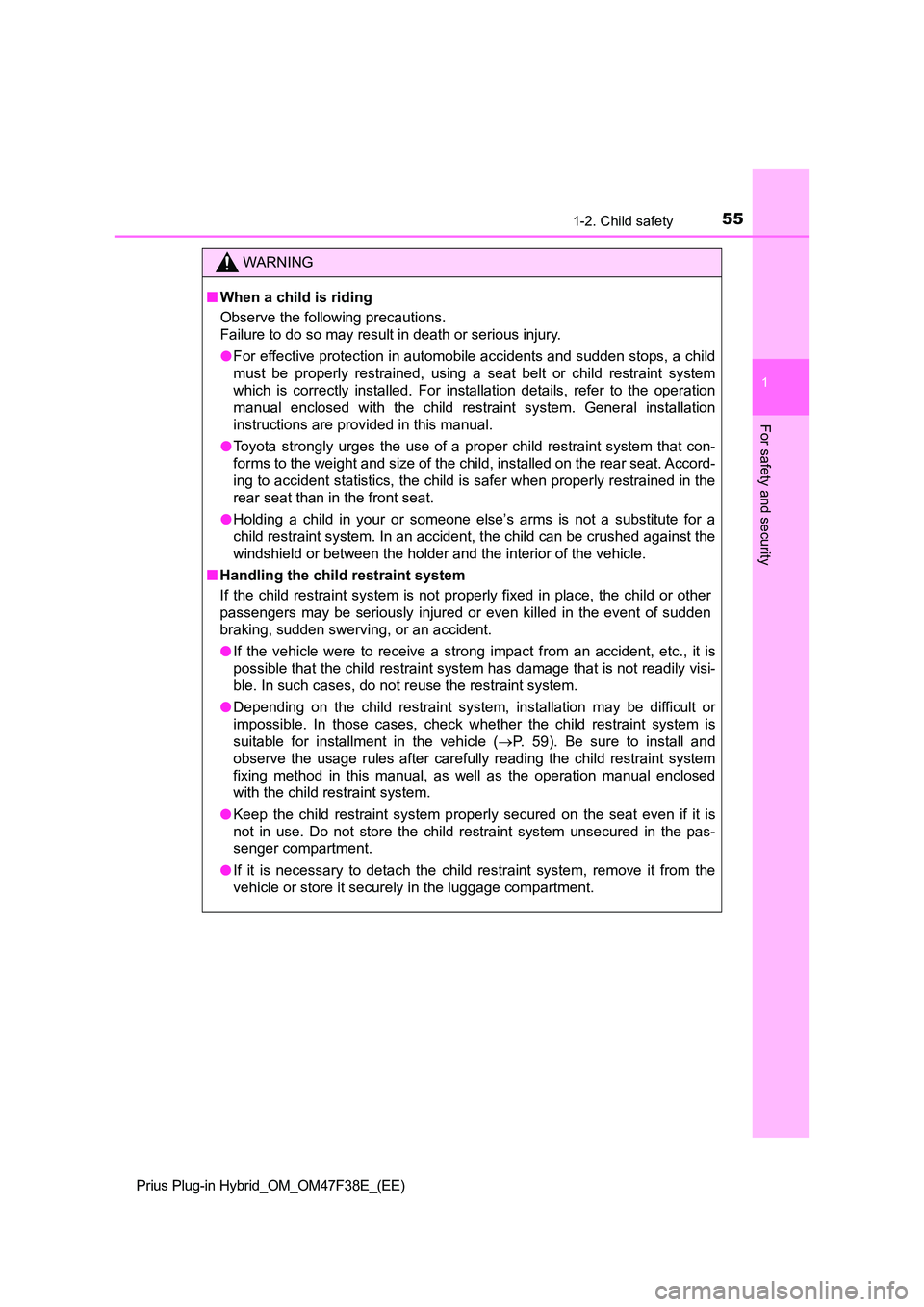
551-2. Child safety
1
Prius Plug-in Hybrid_OM_OM47F38E_(EE)
For safety and security
WARNING
■When a child is riding
Observe the following precautions.
Failure to do so may result in death or serious injury.
● For effective protection in automobile accidents and sudden stops, a child
must be properly restrained, using a seat belt or child restraint system
which is correctly installed. For inst allation details, refer to the operation
manual enclosed with the child restraint system. General installation
instructions are provided in this manual.
● Toyota strongly urges the use of a proper child restraint system that con-
forms to the weight and size of the child, installed on the rear seat. Accord-
ing to accident statistics, the child is safer when properly restrained in the
rear seat than in the front seat.
● Holding a child in your or someone else’s arms is not a substitute for a
child restraint system. In an accident, the child can be crushed against the
windshield or between the holder and the interior of the vehicle.
■ Handling the child restraint system
If the child restraint system is not properly fixed in place, the child or other
passengers may be seriously injured or even killed in the event of sudden
braking, sudden swerving, or an accident.
● If the vehicle were to receive a strong impact from an accident, etc., it is
possible that the child restraint system has damage that is not readily visi-
ble. In such cases, do not reuse the restraint system.
● Depending on the child restraint system, installation may be difficult or
impossible. In those cases, check whether the child restraint system is
suitable for installment in the vehicle ( P. 59). Be sure to install and
observe the usage rules after carefully reading the child restraint system
fixing method in this manual, as well as the operation manual enclosed
with the child restraint system.
● Keep the child restraint system properly secured on the seat even if it is
not in use. Do not store the child restraint system unsecured in the pas-
senger compartment.
● If it is necessary to detach the child restraint system, remove it from the
vehicle or store it securely in the luggage compartment.
Page 61 of 818

591-2. Child safety
1
Prius Plug-in Hybrid_OM_OM47F38E_(EE)
For safety and security
■Child restraint system compatibility for each seating position
Compatibility of each seating position with child restraint systems
( P. 61) displays the type of child restraint systems that can be
used and possible seating positions for installation using symbols.
Also, the recommended child restraint system that is suitable for
your child can be selected.
Otherwise, check [Recommended child restraint systems informa-
tion] for recommended child restraint systems. ( P. 6 6 )
Check the selected child restraint system together with the follow-
ing [Before confirming the compatibility of each seating position
with child restraint systems].
■Before confirming the compatibility of each seating position
with child restraint systems
Checking the child restraint system standards.
Use a child restraint system that conforms to UN(ECE) R44*1 or
UN(ECE) R129*1, 2.
The following approval mark is displayed on child restraint sys-
tems which are conformed.
Check for an approval mark attached to the child restraint sys-
tem.
Example of the displayed
regulation number
UN(ECE) R44 approval
mark*3
The weight range of the
child who is applicable for
an UN(ECE) R44 approval
mark is indicated.
UN(ECE) R129 approval
mark*3
The height range of the
child who is applicable as
well as available weights
for an UN(ECE) R129
approval mark is indicated.
Child restraint system compatibility for each seating position
1
1
2
Page 67 of 818
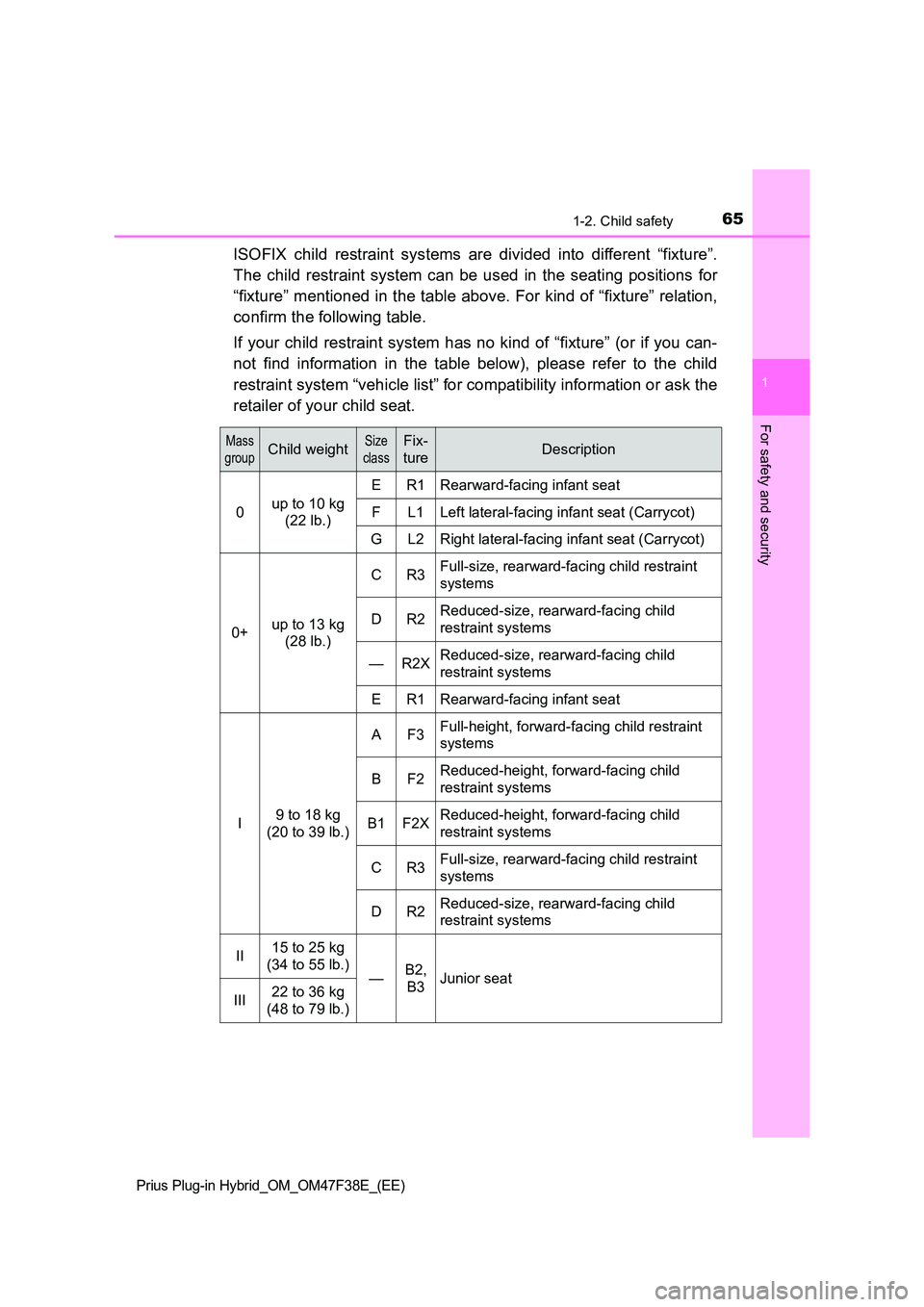
651-2. Child safety
1
Prius Plug-in Hybrid_OM_OM47F38E_(EE)
For safety and security
ISOFIX child restraint systems are divided into different “fixture”.
The child restraint system can be used in the seating positions for
“fixture” mentioned in the table above. For kind of “fixture” relation,
confirm the following table.
If your child restraint system has no kind of “fixture” (or if you can-
not find information in the table below), please refer to the child
restraint system “vehicle list” for compatibility information or ask the
retailer of your child seat.
Mass
groupChild weightSize
class
Fix-
tureDescription
0up to 10 kg
(22 lb.)
ER1Rearward-facing infant seat
FL1Left lateral-facing infant seat (Carrycot)
GL2Right lateral-facing infant seat (Carrycot)
0+up to 13 kg
(28 lb.)
CR3Full-size, rearward-facing child restraint
systems
DR2Reduced-size, rearward-facing child
restraint systems
—R2XReduced-size, rearward-facing child
restraint systems
ER1Rearward-facing infant seat
I9 to 18 kg
(20 to 39 lb.)
AF3Full-height, forward-facing child restraint
systems
BF2Reduced-height, forward-facing child
restraint systems
B1F2XReduced-height, forward-facing child
restraint systems
CR3Full-size, rearward-facing child restraint
systems
DR2Reduced-size, rearward-facing child
restraint systems
II15 to 25 kg
(34 to 55 lb.)—B2,
B3Junior seat
III22 to 36 kg
(48 to 79 lb.)
Page 112 of 818

1102-1. Plug-in hybrid system
Prius Plug-in Hybrid_OM_OM47F38E_(EE)
The distance that can be driven in EV mode varies significantly
depending on how the vehicle is driven, road conditions, the weather,
the outside temperature, usage conditions of electrical components
and the number of occupants.
The distance that can be driven in EV mode can be extended if the fol-
lowing is performed:
●Maintain a safe distance from the vehicle in front and avoid unnec-
essary acceleration and deceleration
●Accelerate and decelerate the vehicle as smoothly as possible
●Drive at moderate speeds as much as possible and maintain a con-
stant speed
●
Set the air conditioning to a moderate temperature and turn the “A/C”
switch ( ) off when it is not needed
●Use tires of the specified size and maintain the specified tire pres-
sure
●Use the EV/HV mode selection switch to drive in HV mode when
driving on a highway
Electricity consumption will increase substantially when driving on a
highway in EV mode.
●Do not add unnecessary weight to the vehicle
The following indicate that charging has been carried out properly.
●The charging indicator turns off
●The Hybrid battery (traction battery) status indicators illuminate for
approximately 15 seconds. (P. 1 1 3 )
●“Charging Complete” is displayed on the multi-information display
when starting off (P. 149)
Regardless of the type of power source or whether the charging
schedule function is used, charging is completed if the above can be
confirmed.
Charging-related messages: P. 1 8 7
Tips for extending the EV driving range
Display when charging is completed
Page 553 of 818
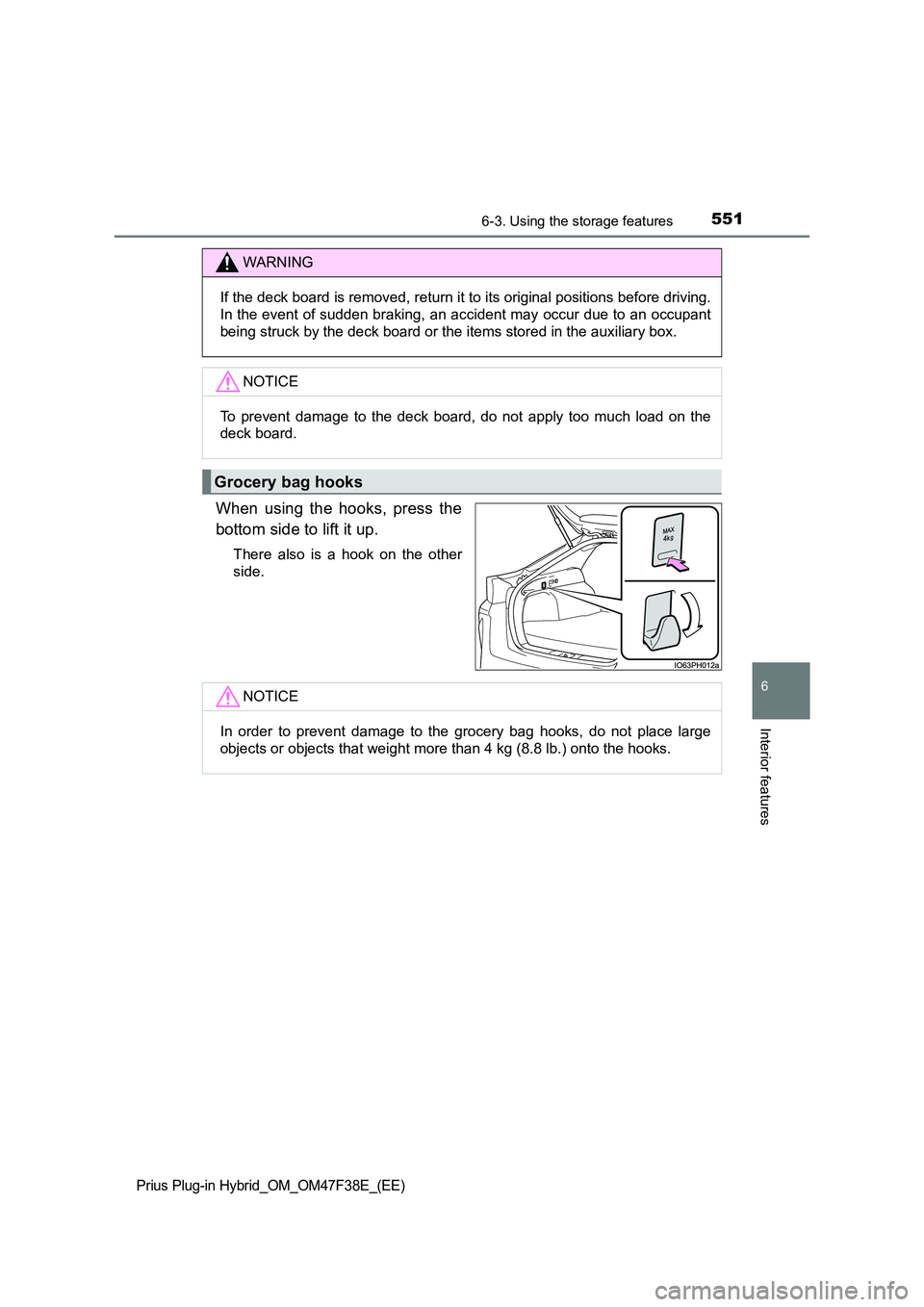
5516-3. Using the storage features
Prius Plug-in Hybrid_OM_OM47F38E_(EE)
6
Interior features
When using the hooks, press the
bottom side to lift it up.
There also is a hook on the other
side.
WARNING
If the deck board is removed, return it to its original positions before driving.
In the event of sudden braking, an accident may occur due to an occupant
being struck by the deck board or the items stored in the auxiliary box.
NOTICE
To prevent damage to the deck board, do not apply too much load on the
deck board.
Grocery bag hooks
NOTICE
In order to prevent damage to the grocery bag hooks, do not place large
objects or objects that weight more than 4 kg (8.8 lb.) onto the hooks.
Page 603 of 818
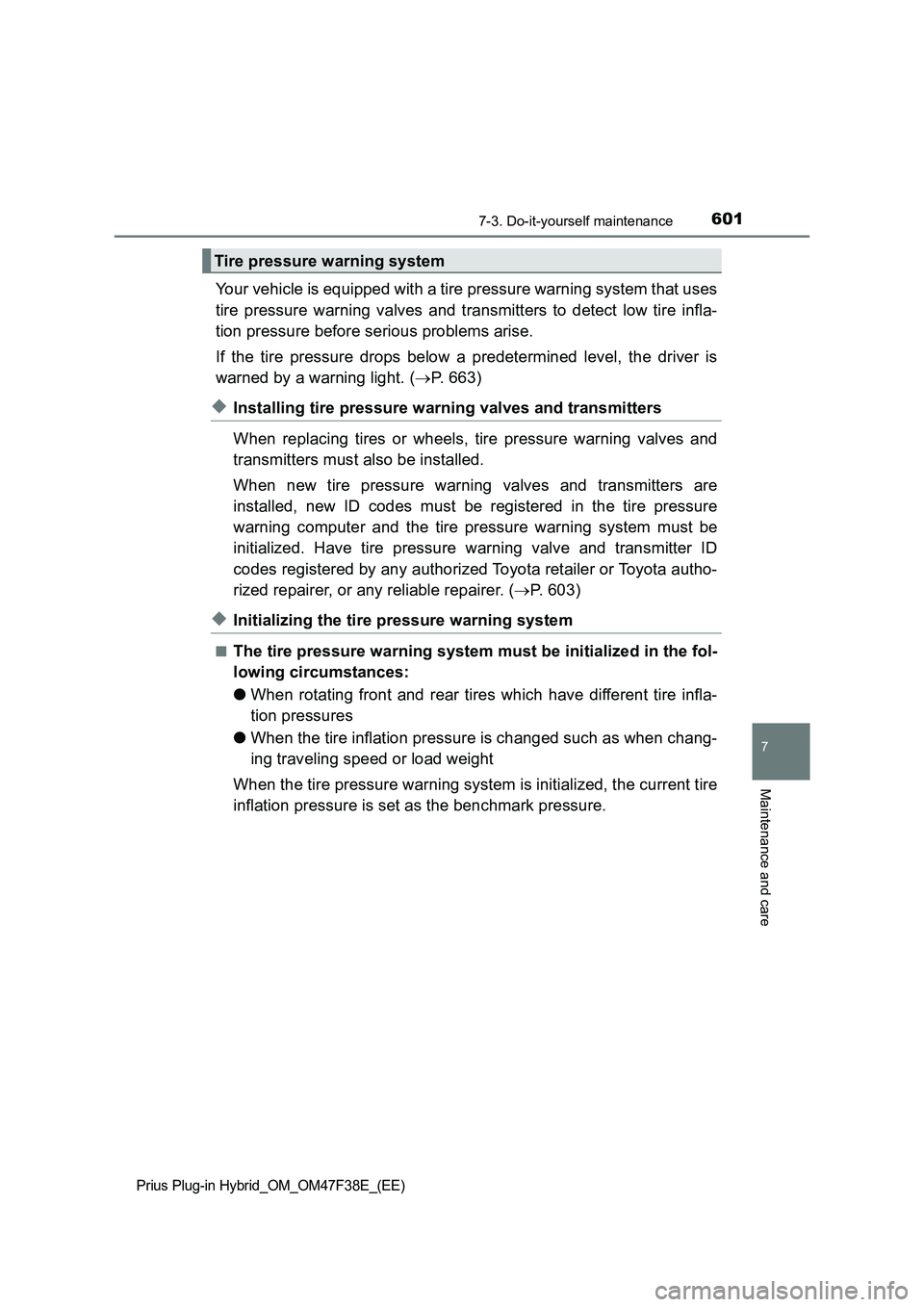
6017-3. Do-it-yourself maintenance
Prius Plug-in Hybrid_OM_OM47F38E_(EE)
7
Maintenance and care
Your vehicle is equipped with a tire pressure warning system that uses
tire pressure warning valves and transmitters to detect low tire infla-
tion pressure before serious problems arise.
If the tire pressure drops below a predetermined level, the driver is
warned by a warning light. (P. 663)
◆Installing tire pressure warning valves and transmitters
When replacing tires or wheels, tire pressure warning valves and
transmitters must also be installed.
When new tire pressure warning valves and transmitters are
installed, new ID codes must be registered in the tire pressure
warning computer and the tire pressure warning system must be
initialized. Have tire pressure warning valve and transmitter ID
codes registered by any authorized Toyota retailer or Toyota autho-
rized repairer, or any reliable repairer. (P. 603)
◆Initializing the tire pressure warning system
■The tire pressure warning system must be initialized in the fol-
lowing circumstances:
●When rotating front and rear tires which have different tire infla-
tion pressures
●When the tire inflation pressure is changed such as when chang-
ing traveling speed or load weight
When the tire pressure warning system is initialized, the current tire
inflation pressure is set as the benchmark pressure.
Tire pressure warning system
Page 610 of 818
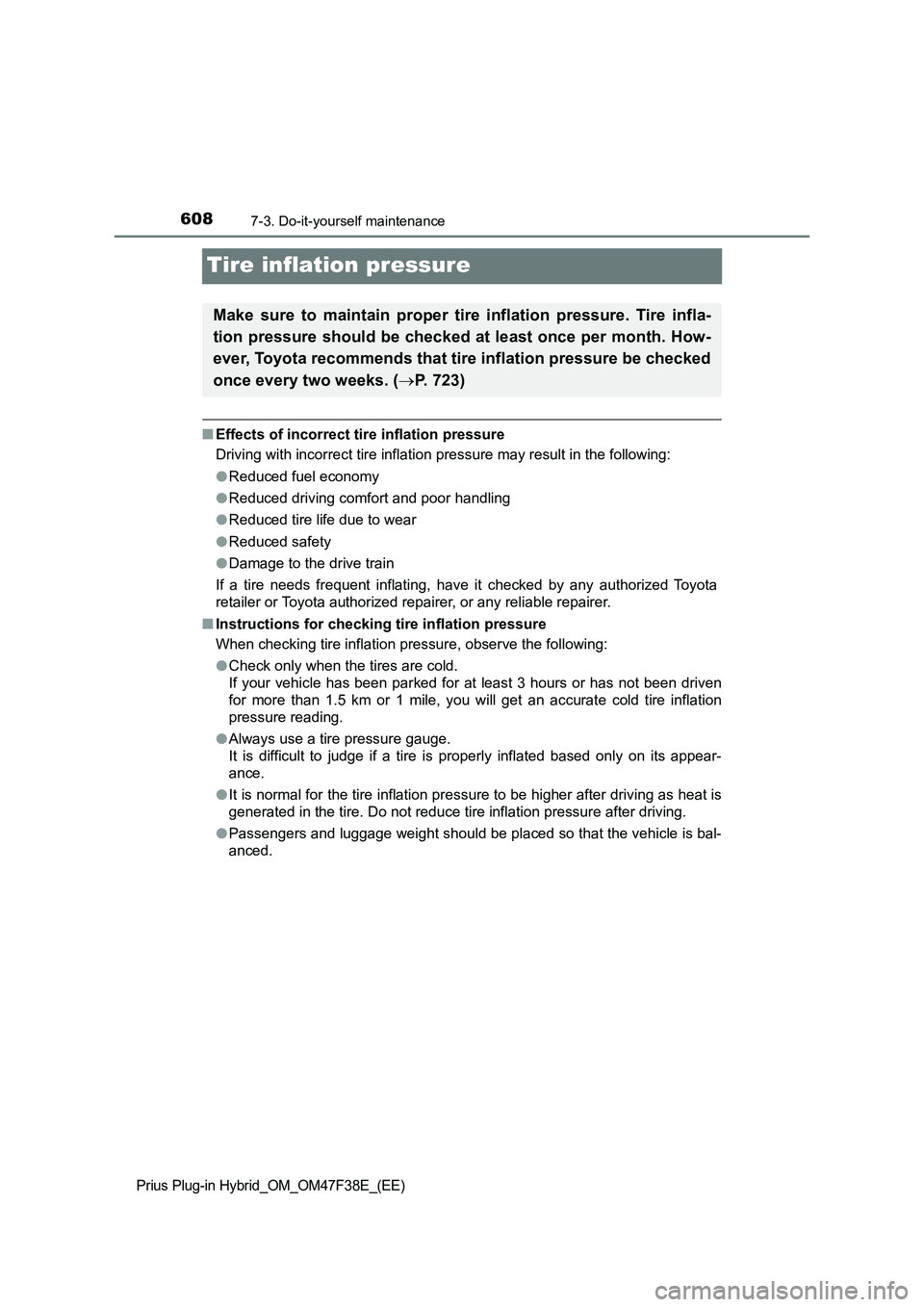
6087-3. Do-it-yourself maintenance
Prius Plug-in Hybrid_OM_OM47F38E_(EE)
Tire inflation pressure
■Effects of incorrect tire inflation pressure
Driving with incorrect tire inflation pressure may result in the following:
●Reduced fuel economy
●Reduced driving comfort and poor handling
●Reduced tire life due to wear
●Reduced safety
●Damage to the drive train
If a tire needs frequent inflating, have it checked by any authorized Toyota
retailer or Toyota authorized repairer, or any reliable repairer.
■Instructions for checking tire inflation pressure
When checking tire inflation pressure, observe the following:
●Check only when the tires are cold.
If your vehicle has been parked for at least 3 hours or has not been driven
for more than 1.5 km or 1 mile, you will get an accurate cold tire inflation
pressure reading.
●Always use a tire pressure gauge.
It is difficult to judge if a tire is properly inflated based only on its appear-
ance.
●It is normal for the tire inflation pressure to be higher after driving as heat is
generated in the tire. Do not reduce tire inflation pressure after driving.
●Passengers and luggage weight should be placed so that the vehicle is bal-
anced.
Make sure to maintain proper tire inflation pressure. Tire infla-
tion pressure should be checked at least once per month. How-
ever, Toyota recommends that tire inflation pressure be checked
once every two weeks. (P. 723)
Page 612 of 818
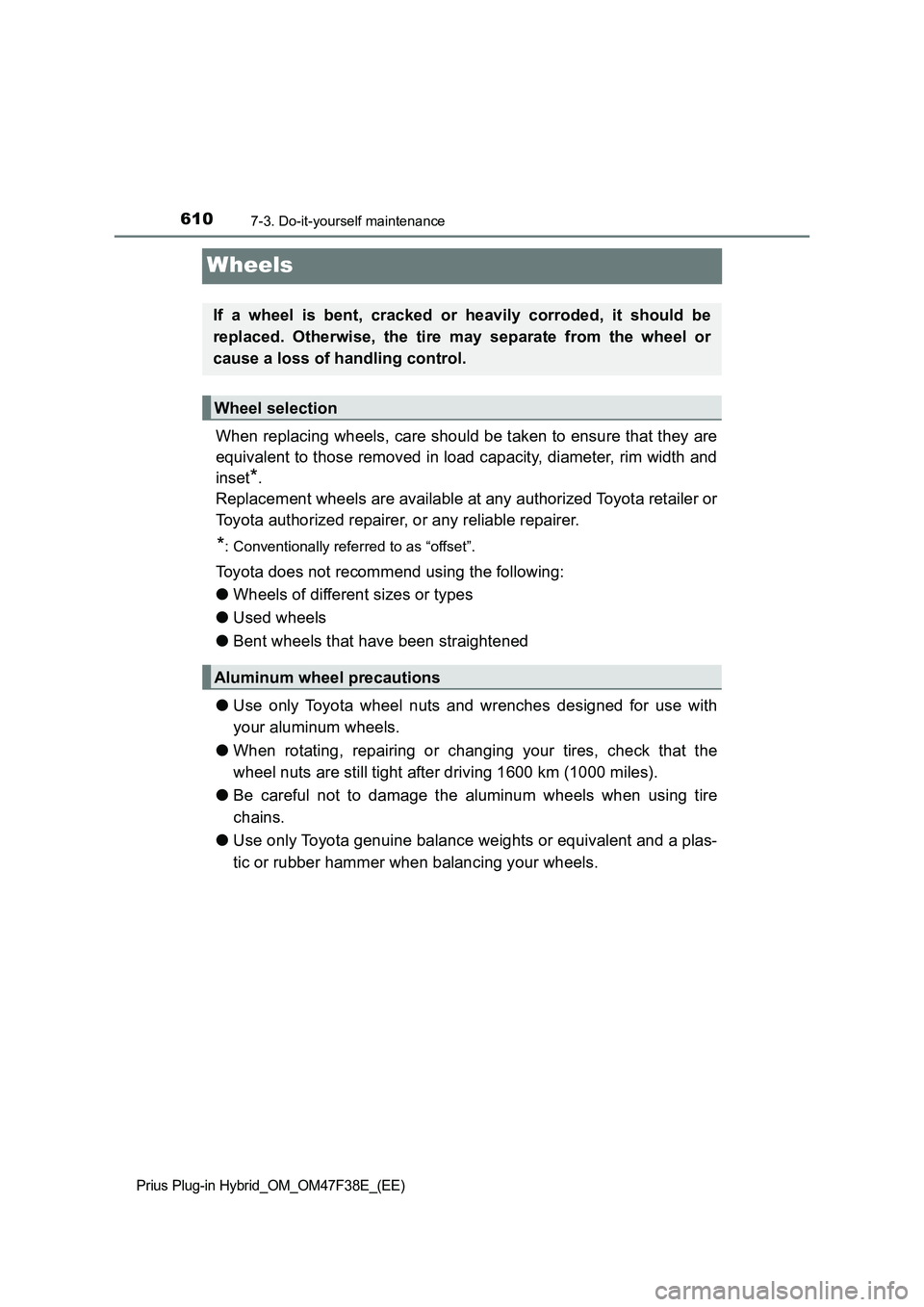
6107-3. Do-it-yourself maintenance
Prius Plug-in Hybrid_OM_OM47F38E_(EE)
Wheels
When replacing wheels, care should be taken to ensure that they are
equivalent to those removed in load capacity, diameter, rim width and
inset
*.
Replacement wheels are available at any authorized Toyota retailer or
Toyota authorized repairer, or any reliable repairer.
*: Conventionally referred to as “offset”.
Toyota does not recommend using the following:
●Wheels of different sizes or types
●Used wheels
●Bent wheels that have been straightened
●Use only Toyota wheel nuts and wrenches designed for use with
your aluminum wheels.
●When rotating, repairing or changing your tires, check that the
wheel nuts are still tight after driving 1600 km (1000 miles).
●Be careful not to damage the aluminum wheels when using tire
chains.
●Use only Toyota genuine balance weights or equivalent and a plas-
tic or rubber hammer when balancing your wheels.
If a wheel is bent, cracked or heavily corroded, it should be
replaced. Otherwise, the tire may separate from the wheel or
cause a loss of handling control.
Wheel selection
Aluminum wheel precautions